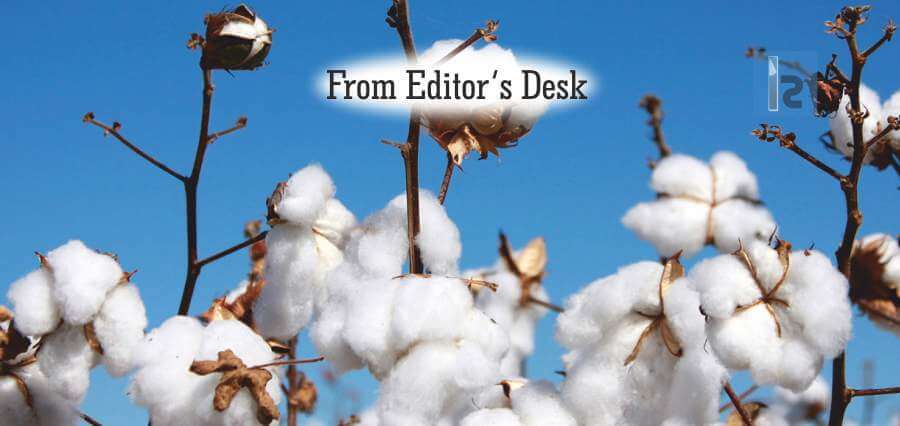The Textile Industry is one of the oldest industries in India and manufactures the raw feed for the most essential consumer good, clothing. Textile or fabrics of various sizes, color, shine, feel and fall is manufactured here which are then woven into different clothing item and goods. While Apparel Industry is the biggest consumer of Textile Products as it manufactures clothes for people to wear, textile or fabric is used in other industries too like automobile (think car seats or even filters), footwear (shoes use fabric), packaging etc.
The Murky Side
The textile industry is crucial for a country’s overall economic growth. With this huge onus, also lies an albatross around the industries neck, that of being a polluting one. Of late the waste and polluting side of the textile industry has been in focus and a great cause of concern. Use of chemicals and gallons of water during the manufacturing process, heavy and old machinery, and waste pieces of fabric, both pre-consumer and post-consumer use, filling up the landfills are key issues that need to be addressed like an emergency situation.
Redefining the Process
Efforts are being taken and various solutions are being offered for the Textile industry to become sustainable and manage its waste efficiently. The methodologies involve using natural resources, renewable energy, better planning and efficient use of resources, eco-friendly manufacturing processes, and better coordination with consumers. Here are few strategies that will help address the issue at hand.
Refashioning means redesigning a piece of clothing and putting it back into the mainstream. We all know about factory seconds that are generally put up on sale at a low cost. Apart from putting the lots on sale, many small companies take this perfectly new clothing, re-cut and refashion them into a new and stylish piece of clothing and put them in stores. For example, a pair of denim can be easily refashioned into denim shorts.
Recycle of fabric scraps or cloth that is beyond repair and reuse is the most effective solution. Rather than dumping such cloth items, they are shredded and decomposed using eco-friendly methods and then put to use. Examples include manufacturing industrial use textiles, ropes, fillings etc.
Reuse is pretty common in an Indian household and needs to be adopted at a large scale in the industries too. Clothing items with minor defects can be put out for sale at lower costs, scraps and shreds can be reused in small industries like rugs and carpet manufacturing. There are many companies and innovative startups with are giving new life to old shreds of textile making them unique and fashionable. The textile industries can tie up with them for better deals that benefit all.
Using Alternate Resources that use less water and chemicals and are biodegradable will sure be a big leap. The textile industry is mostly dependent on raw material like cotton, silk and synthetic fibers like nylon. While cotton is a crop that uses a lot of water and once turned into cloth, takes too much time to degenerate, the synthetic material is well, synthetic and unnatural involving chemical processes, to say the least. Alternative fiber sources such as jute, hemp, and even coffee grounds and orange or pineapple peels can be used to make fabric. These new researches are very eco-friendly and sustainable and need to be adopted on a large scale.
Steps that Benefit All
While the immediate effect on nature that these methods will have is easy to see, it will also help small-scale industries and generate more employment. After all, being sustainable involves doing good to nature and society too. Here’s how.
The recycling and reusing processes require the collection, sorting, and distribution of textile products. This will involve more people who can invest time and labor and get paid for it thus generating new employment opportunities.
Reusing and redesigning fabric pieces into a new product are again tasks that can benefit individual designers and small companies. It also gives work to those involved in creating hand-made goods. They can utilize industrial samples or discards to make fashion accessories like cloth handbags, hairband, canvas shoes, and even jewelry. These fabric-based products are better, stronger and eco-friendly.
Small scraps of fabric, with innovation from a Cambodian company, are now being used to make recycled paper which makes for great hangtags. This shows ways to utilize the waste of one industry by the other. These scraps can be used for making recycled paper, threads, yarns, ropes and recycled cloth too.
Refashioning makes good and quality clothing more affordable. High priced clothing which couldn’t make it out of the factory due to a faulty zip can be easily refashioned into another piece of clothing by a small scale designer and bought by someone who wouldn’t have gone for the earlier and expensive version of it.
Using natural methods for making and coloring fabric will help to revive the age-old Indian traditions and handicraft sector. Using plant-based natural colors or utilizing agricultural waste to manufacture fabric will help the cottage industry and the farmers too.
Clothes are a basic necessity for the humankind. The textile industry has long served this purpose but the cost has been born by Mother Nature. It is now high time to consider ways that can be incorporated and give the best to both mankind and nature. New processes and innovations have made sure that there are plenty of ways to do. All that waits is a mass adaptation of sustainable methods and awareness for the general population to lend a hand in this mission.

Insights Success stands as the epitome of trust and authority. It has earned its reputation as the foremost source of business intelligence, providing readers with a gateway to the pulse of Bharat’s advancing business landscape.
Quick Links
Enquiry
info@insightssuccess.in
for more information on advertising opportunities with Insights Success magazine.
8793630422 / 24
Reach out to Us
Insights Success Media and Technology Pvt. Ltd.
512, Brand Square,
Kunal Icon Rd, Pimple Saudagar,
Pune, Maharashtra 411027

